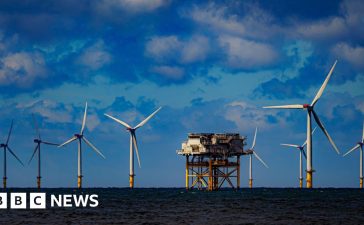Ford’s next-generation electric vehicle architecture will land in 2025, with the first vehicle to be a three-row sport utility vehicle with 350 miles of range that’s inspired by the automaker’s popular Expedition SUV.
The announcement came during Ford’s capital markets day on Monday, which also included a flurry of battery material news. The company outlined new supply deals for battery-grade lithium to produce 2 million electric vehicles by 2026. But mainly, the capital markets event was intended to show how Ford can close the gap with its competitors — namely Tesla, which still dominates the EV market in the US.
Ford’s first next-gen EV will be a three-row sport utility vehicle with 350 miles of range
Details are still scarce, but the new electric Expedition-like SUV will sit alongside an electric Europe-only Ford Explorer as well as the automaker’s Mustang Mach-E, F-150 Lightning, and E-Transit van, as Ford’s family of electric vehicles begins to fill out by the midpoint of the decade.
The company also has a new electric truck under development, codenamed T3, which will be built at its massive new EV manufacturing complex in western Tennessee. And Ford CEO Jim Farley even teased a “third generation” EV that will represent a “leap forward” for the company’s lineup.
The battery in Ford’s next-gen EVs will use a lithium iron phosphate chemistry that the company says will be more durable, faster charging, and more affordable than its current lineup of EVs.
That will be achieved by squeezing more efficiency out of less capacity, according to Doug Field, vice president of electrification and software. He explained how the old chemistry enables a 150kWh battery to produce 300 miles of range, while the new one will permit a smaller 100kWh battery to power a vehicle for 350 miles of range. A lot still depends on the size of the vehicle and the efficiency that can be achieved through improved aerodynamics, for example.
“We think numbers like 350 [miles] mix [of city and highway driving speeds], 300 [miles] at highway speeds, plus super-fast charging is a really great combination,” Field said. “And we want to push that energy even lower.”
Thanks to the Mustang Mach-E and F-150 Lightning, Ford is now the No. 2 seller of EVs in the US — and it’s intent on cementing its position with new offerings, more affordable prices, and boosted production targets. It recently doubled production of Mustang Mach-Es to bring its annual manufacturing run rate to a targeted 210,000 units by the end of 2023. Ford also announced it would slash prices on the Mustang Mach-E after the No. 1 EV seller, Tesla, also reduced its prices.
Of course, the pivot to electric vehicles is proving to be incredibly expensive for Ford. The company has said it expects to lose $3 billion this year on its EV sales as it continues to funnel profits from its Ford Blue internal combustion engine and business-to-business Ford Pro divisions into its costly electrification strategy.
Of course, the pivot to electric vehicles is proving to be incredibly expensive for Ford
It’s paying off in increased sales. Ford says its EV business grew 41 percent in the first quarter on sales of 10,866 units. That includes 4,291 F-150 Lightning trucks and a 62.7 percent increase in E-Transit delivery vans. Sales of Mustang Mach-Es were down, reflecting downtime at the factory for changes designed to improve production. Ford said it’s still on track to hit a run rate of 150,000 EVs this year — hopefully without any more recalls.
But investors were still skeptical about Ford’s plan to continue to burn piles of cash as it competes with dominant players like Tesla and China’s BYD, which produces several low-cost EVs for the Chinese market. Ford’s executives stressed that software revenue, from expenses like subscription to hands-free driving features and through its Ford Pro division, should help bolster its profit margins.
“What we want to learn is the fitness cycle between getting data off the vehicle, changing the software, shipping it back to the vehicle, getting tighter and faster and faster,” Farley said in response to a question about cash burn. “That to us is as important as anything.”











